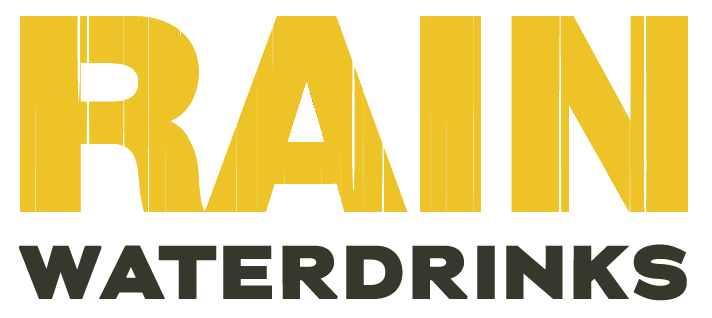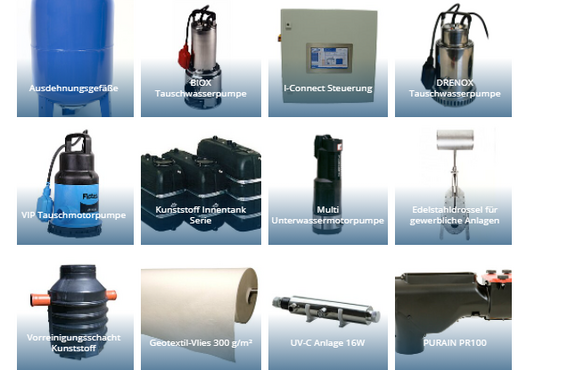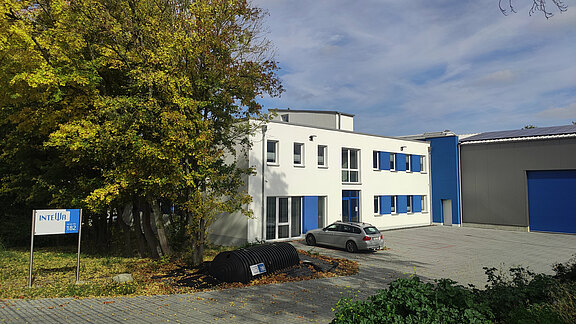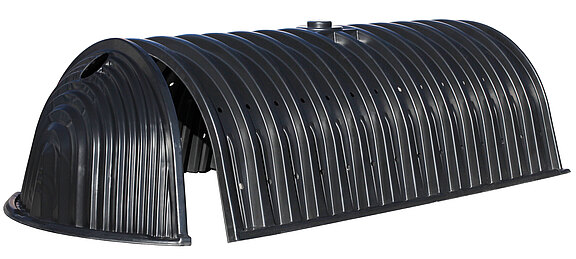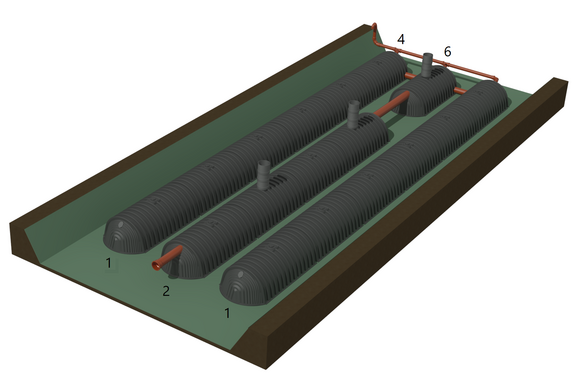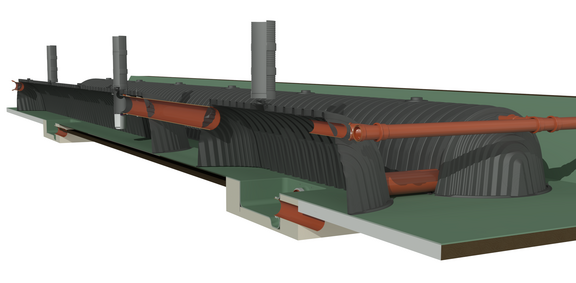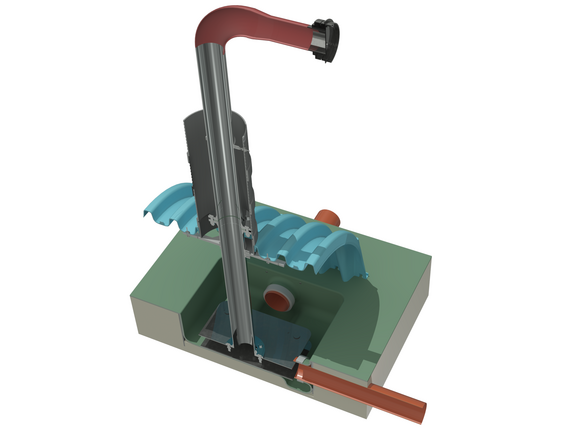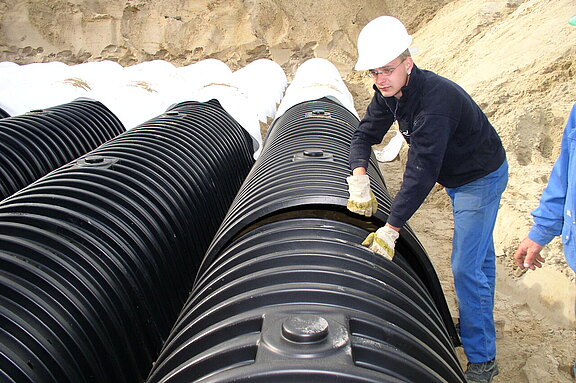New systems for "stormwater management, water storage and subsurface irrigation"
The direct effects of increasing surface sealing can be felt everywhere. Most noticeable are the rising costs for rainwater drainage and flood damage.
Introduction
The direct effects of increasing surface sealing can be felt everywhere. Most noticeable are the rising costs for rainwater drainage and flood damage. In recent years, however, a process of rethinking has taken place. The old goals of centralised treatment of rainwater are being revised. The idea of decentralised infiltration at the point of origin is gaining ground and is becoming an essential component of sustainable rainwater management - for the benefit of citizens and the environment. Increasingly, decentralised infiltration and on-site retention are also being demanded by the authorities. More and more cities and municipalities are demanding and promoting these measures, in part through more favourable wastewater charges, by exempting rainwater from charges or through subsidies for unsealing and infiltration measures, so-called "rainwater management".
The combination of rainwater management with water storage for later use in the building or for irrigation or cooling of the surrounding area are components of sustainable water management that have hardly been used to date. However, such a combination of rainwater management with utilisation and storage options can significantly increase the efficiency of these sustainable technologies. In this context, this article highlights a new, innovative, modular system series with tunnel elements made of plastic, which should now enable cost-effective and easy-to-implement solutions for combining rainwater management, water storage and underground irrigation.
State of the art in rainwater infiltration and retention
Known technologies include infiltration and retention systems with buried plastic storage elements, retention and water storage systems sealed with plastic sheeting, and separate shafts for water inflow and outflow, such as throttle drains. In addition, various pre-cleaning systems such as filter shafts, sedimentation pipes and filtration rows are known to reduce impurities in the water before storage or infiltration. The disadvantages include high costs due to the installation of additional shafts for inlet and outlet, which not only leads to increased space requirements, but also to higher transport costs and increased installation costs. Furthermore, the lack of modularity due to different shaft diameters makes the flexible customisation and modular design of these systems difficult. None of the known systems allow simultaneous or modular use as rainwater management, water storage and irrigation systems.
The system for "rainwater management, water storage and subsurface irrigation"
The newly developed system for "rainwater management, water storage and subsurface irrigation" consists of an innovative configuration of tunnel-shaped plastic elements that have been specially developed for installation in the ground (1). These elements are designed to have an integrated sedimentation module, shown as the centre row of tunnels on the left of the sketch (2). This sedimentation section allows sediments to settle in the water before the water enters the system, thereby providing pre-cleaning. The sedimentation section also acts as a water reservoir.
The system also has an integrated overflow filter (3). In addition, the system has integrated cleaning and drainage shafts (4), which allow the system to be maintained, cleaned and water to be drained if necessary. There is also an integrated pump sump (5), which allows water to be pumped out in a targeted manner if necessary.
A central element of this system is the distribution element, which is shown in the sketch as the centre row of tunnels on the right with the four side pipes (6). This distribution element is designed in such a way that it drains the water from the sedimentation and filter row when it is full of water. This prevents the water from being backed up into the inlet and possible dirt from entering other tunnel rows via a potential inlet distributor pipe. This system therefore enables a targeted and controlled distribution of the cleaned water.
The combination of these different elements provides an efficient and multifunctional infiltration and retention system that enables both pre-treatment, storage and controlled distribution of water. This innovative system addresses potential problems such as sedimentation, cleaning, overloading and contamination and represents a promising advance in the field of stormwater management.
The new technology enables a large matrix of possible applications and combinations in sustainable water management:
- DM RWN-S rainwater utilisation system
- DM RWV-S / DM RWR-S Rainwater infiltration/retention system
- DM RWV-KKA Infiltration of drainage water from a small wastewater treatment plant
- DM LW-S extinguishing water system
- DM UF-S Underfloor irrigation and evaporation system
The exciting thing is that almost all applications can also be combined with each other. For example, a rainwater retention system can also be used in parallel as a water storage tank or for underfloor irrigation.
System components
Only very few components are required to assemble the systems and/or packages, which can be put together in a modular fashion:
DM-T type 60 and spherical caps, DIBt certified
DM tunnel sump with drain opening DN150
GTB - Fabric
GTV - Fleece
EPDM film with special adhesive for pipe penetrations
Filter and overflow element
PLURAFIT maintenance shaft with various covers
I-CONNECT as a browser-based monitoring and control system
Adjustable throttle drain
DM extinguishing water intake nozzle with anti-swirl plate and flange
Pre-cleaning, inlet and distribution of water in the system
If the inflow into the system is rainwater, pre-treatment plays an important role. With the help of simple assessment procedures, the pollution of underground and surface water by rainwater from roof surfaces and traffic areas can be considered qualitatively and quantitatively (ATV DVWK-M153 and soon DWA-A102). Depending on the results, various rainwater treatment measures must be taken to ensure adequate water protection. If discharged into a trench, this must also be protected by at least coarse filtration. Important for rainwater utilisation cisterns: According to DIN 1989-1, underground infiltration systems (infiltration trenches) are equivalent to infiltration systems with a living soil zone with regard to qualitative aspects if the inflow water from a rainwater utilisation system originates from non-metallic roof surfaces. Systems with a settling chamber in which the flow conditions allow specifically heavier substances to sink to the bottom as water and specifically lighter substances to float to the top are referred to as sedimentation systems. Collection and filter shafts consist of a sedimentation area, in which the heavy particles settle, and a filter screen, which prevents light coarse pollutants from entering the downstream storage tank. Light substances are also retained in the shaft via an immersion pipe. Depending on the amount of dirt ingress, they must be cleaned regularly. The entire roof run-off water is filtered and fed into the storage tank.
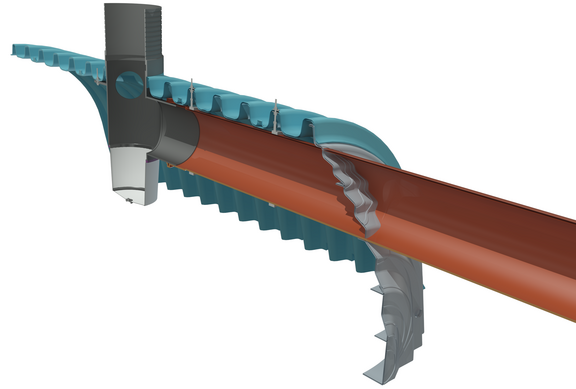
In the DRAINMAX system, the water from less polluted areas, such as roof surfaces, can be connected directly to the sedimentation filter and storage series. Depending on the connected area, the row is simply extended and the inlet and outlet diameters enlarged.
If run-off water from contaminated areas, such as road run-off water, is also to be discharged, this can be done via the ground surface via the revitalised soil zone. In this case, the system or parts of the system are designed as a trough infiltration system. Here too, a combination with the design as a subsurface irrigation system is an interesting solution in practice.
As the water can escape through the water-permeable sides via a special fabric into the neighbouring rows, this volume is also available for use or retention, which results in a lower price and smaller installation space. The sludge fed in is shifted towards the centre of the tunnel to the pump sump. During maintenance, the entire row there can be cleaned via the maintenance shaft using a flushing nozzle and suction carriage. To prevent dirt from entering the other rows of infiltration trenches via the inlet in the event of heavy rainfall, all the water is channelled into the distribution row via the emergency overflow in the event of an overflow. This could also be cleaned via a further shaft and pump sump in the event of maintenance.
Installation steps
No special materials are required to install the systems. All the necessary components are included in the packages. Pre-assembled EPDM sheets are used for the water storage solutions so that no further processing by gluing or vulcanising is required on site. This means that the systems can be professionally installed by any civil engineering company.
The following table shows the individual installation steps for installing the various applications:
Stormwater management | Water reservoir | Underfloor irrigation | ||||
RWV-S | KKV-S | RWR-S | RWN-S | LW-S | UF-S | |
| Excavate pit | x | x | x | x | x | x |
| Laying GTV protective fleece |
|
| x | x | x |
|
| Laying GTB fabric | x | x |
|
|
|
|
| Laying EPDM film |
|
| x | x | x | x |
| Laying GTV protective fleece |
|
| x | x | x |
|
| Laying inlets and overflows | x | x | x | x |
|
|
| Laying pump sumps | x | x | x | x | x |
|
| Install throttle |
|
| x |
|
|
|
| Install extinguishing water extraction |
|
|
|
| x |
|
| Laying DRAINMAX tunnels | x | x | x | x | x | x |
| Install filter and overflow element | x | x | x | x |
|
|
| Couple distributor element |
|
|
| x | x |
|
| Apply 0.9 m 16/32 filler material | x | x | x | x | x |
|
| Apply silty, capillary filling material |
|
|
|
|
| x |
| Laying GTV fleece | x | x | x | x | x |
|
| Apply filling material up to the top edge of the ground | x | x | x | x | x | x |
I-Connect remote monitoring
Each rainwater management and storage system must generally be monitored every six months without monitoring and includes the following measures:
Check the sedimentation and filter area for sludge content using a dipstick
Check sedimentation and filter area for leaks
Check pre-filter for flow rate and contamination
Check throttle outlet for free movement, soiling or blockage
For storage tanks: Check water level and tightness
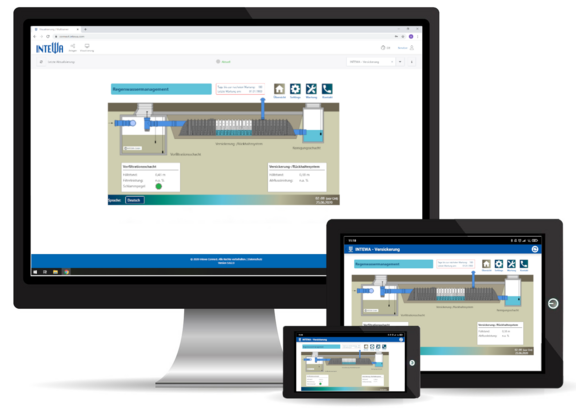
This inspection usually has to be carried out by two employees, resulting in high and unnecessary costs. To solve this problem and save unnecessary costs for the operator, INTEWA has developed the new INTEWA CONNECT technology, which can now monitor these systems remotely. Checking the drainage capacity of the infiltration trench is also only possible with I-CONNECT.
In order to be able to monitor and remotely maintain the systems, they are equipped with sensors that supply the data to a central control unit, the I-CONNECT. From there, the data is transferred to the INTEWA cloud server via a secure internet connection. Using the I-CONNECT application, system operators can now view all the data, such as the infiltration rate, sludge level and filter flow rate of their system online and are informed of any maintenance requirements. This can amortise within approx. 5 years and also increases system reliability.
Summary and outlook
The new system series presented marks a significant advance in the industry due to a number of advantages. The system offers an innovative modular solution with just a few components that is unique for various applications. Industrial property rights have been registered for the system structure and underfloor irrigation, which underlines the innovative strength. The system integrates pre-cleaning, control, flushing and throttling directly into the storage system. This eliminates the need for additional shaft elements, resulting in cost savings of around 30 %. The new system series is characterized by considerable simplification during installation, resulting in significant time savings. Compared to conventional concrete cisterns, around 90 % of transportation costs can be saved. By standardizing package sizes (20, 40, 60, 80, 100 m³ and multiples) as stock items, logistical processes are optimized, resulting in faster delivery readiness. For the first time, these systems can be equipped with an IoT solution (INTEWA I-Connect) as standard, which enables remote monitoring and control and saves further maintenance costs. The system should be available from around EUR 250.00 per cubic meter, including delivery and installation costs, although the price may vary depending on the application, size and delivery location.
The system series presented is therefore not only impressive due to its technological innovation, but also due to its cost-effectiveness and flexibility, which could herald significant progress towards sustainable water management. The market launch is planned for summer 2024.
Author: Oliver Ringelstein, INTEWA GmbH
Characters: 13,597 incl. spaces

